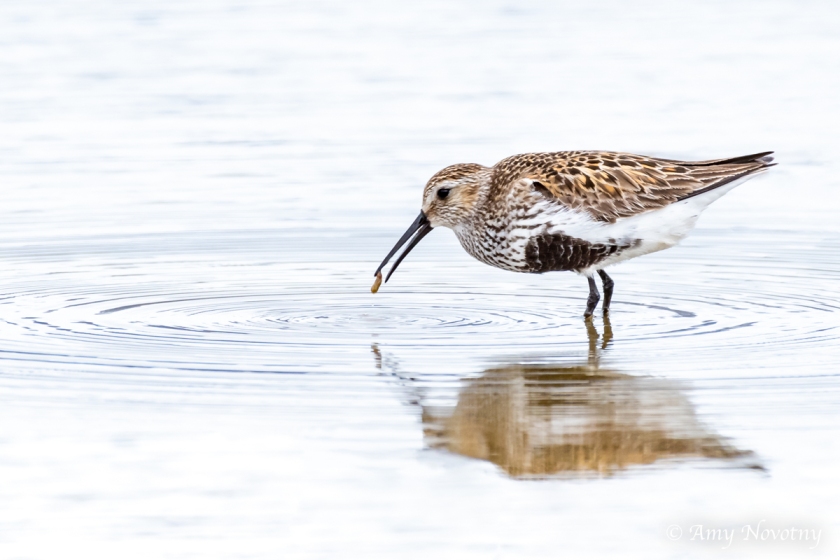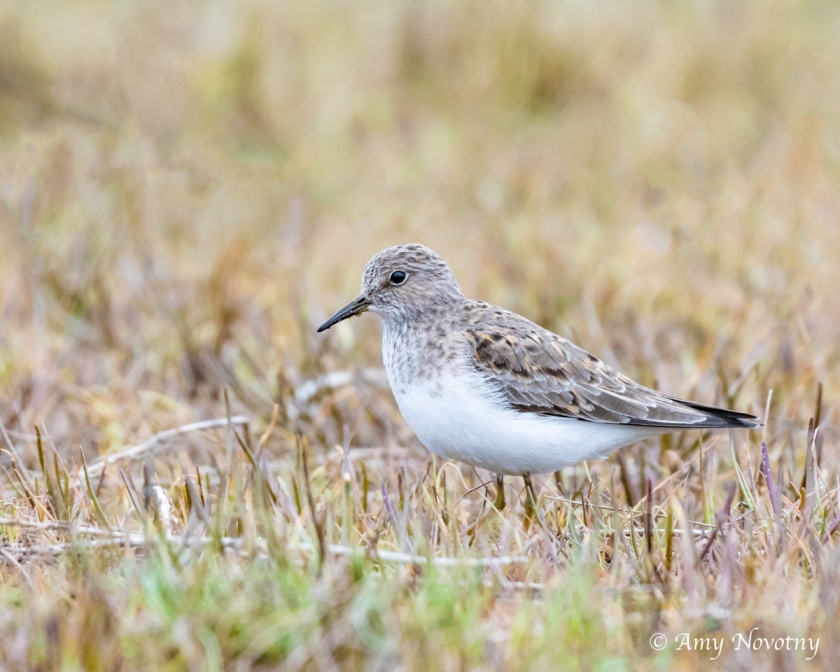
Image: Dunlin feeding on an aquatic invertebrate near the Tana River, Norway; Nikon D500, Nikkor 200-500 mm with 1.4x teleconverter at 700mm, f/8, 1/640 sec, ISO 1000, on tripod
In comparison to Hornøya Island and Ekkerøy bird cliffs where we saw thousands of seabirds, the rest of the areas we visited in Norway had less density of bird populations. As I have learned, sometimes finding a species requires gathering knowledge from others in addition to patience and a bit of luck. We used recommendations from locals, a birding guidebook of the Varanger Peninsula and Artie’s bird photographer friend to help us get to the right areas for specific birds. Once close to these locations, we searched for small pools of water or ponds.
Along the Tana River delta, we took a road through vast expanses of land with little vegetation but with small pools of water. At first glance, we didn’t spot any shorebirds, but when we studied the landscape a little longer, we saw small movements and realized that little brown shorebirds were indeed present, such as the Temminck’s Stint.

Image: Temminck’s Stint looking for a mate in a field near the Tana River, Norway; Nikon D500, Nikkor 200-500 mm with 1.4x teleconverter at 700mm, f/8, 1/400 sec, ISO 1600, on tripod
Although many of these birds appear an earthy brown from afar which helps them blend into their environment, up close their feathers have a wide variety of colors and beauty. This bird below, the Little Stint, was one on Artie’s bucket list and was in full breeding plumage. Dunlin

Image: Little Stint looking for food in a small pool of water near the Tana River, Norway; Nikon D500, Nikkor 200-500 mm with 1.4x teleconverter at 700mm, f/8, 1/800 sec, ISO 800, on tripod
In another location near Gednje, we stopped at a small pond for Anita when she spotted one of her bucket list species—a Red-Throated Loon. These birds are very shy and we had trouble getting close to them. We caught the pair nesting but they are very secretive of the location of their nest and it took a couple hours of watching and waiting to find out where they nest.

Image: Red-Throated Loon swimming in a pond near Gednje, Norway; Nikon D500, Nikkor 200-500 mm with 1.4x teleconverter at 650mm, f/8, 1/1000 sec, ISO 1000, hand-held
Finding this one bird at the pond led us to finding more as we walked around the pond and discovered that this barren landscape was full of life. We caught a Eurasian Golden Plover guarding its nesting area. We never found the exact location of the nest because the bird chirped at us and attempted to draw us away–which worked!

Image: Eurasian Golden Plover calling out on the tundra near Gednje, Norway; Nikon D500, Nikkor 200-500 mm with 1.4x teleconverter at 700mm, f/8, 1/320 sec, ISO 1000, hand-held
As we were photographing that bird, I heard some chirping and looked up at some dead-looking shrubs to find a Bluethroat! This little bird might not look special from the back or when flying a first glance, but when I got my lens on it, the vibrant colors of his chest shocked me! We learned that it tended to rest and stay around a certain low shrub along the pond.

Image: Bluethroat singing on some shrubs near Gednje, Norway; Nikon D500, Nikkor 200-500 mm with 1.4x teleconverter at 650mm, f/8, 1/500 sec, ISO 1000, hand-held
In all of the above images, I added a teleconverter to my setup because we were not in an area where a specialized habitat was confined to a small area such as the bird cliffs. I needed the extra lens length to capture images of these birds since they could easily fly away as soon as we got close to them. It was a good experience to see this side of bird photography as well. 🙂
I wanted to choose the Golden Plover as my fave, but I looked again and they are all amazing in their own right. Great shots Amy. Sounds like you are having a blast!
LikeLiked by 1 person
Aww, Thanks Chris! It’s funny because I really was never interested in photographing small birds, but I have to say that they are so pretty and can make really interesting subjects, not to mention that they are hard little guys to photograph!!!
LikeLike
Wow, these are fantastic. Not sure which ones I like best… but the Bluethroat is very special.
LikeLiked by 1 person
Thanks Muriel! Yes, the Bluethroat is an amazing little guy. I loved hearing him chirp too!
LikeLike
I look forward to your daily post Amy, as it’s wonderful to see native birds of the tundra up close, birds I’ve never seen before. Surprising how patterned and colorful they are too. Thanks for sharing with us all!
LikeLiked by 1 person
Thank you so much Leisa! It really means a lot to me. It’s great to see how different the tundra is and what lives on it. Truly amazing!
LikeLike
All gorgeous photographs of beautiful birds. Thanks for sharing.
LikeLiked by 1 person
Thanks so much Eilene! I have a new appreciation of these little birds.
LikeLiked by 1 person
Amy your blogs and photos are fabulous!!! What a wonderful experience you are having. Thank you for taking the time to blog and for sharing these beautiful birds with us.
Ann
LikeLiked by 1 person
Aww. Thanks so much Ann! I love that you are reading them and following along! I hope you are doing well! Say Hi to DHT for me!
LikeLike
All beautiful especially the Bluethroat.
LikeLiked by 1 person
Thanks so much Becky! I appreciate it! Yes, the Bluethroat shocked me!
LikeLike
I never really considered that there are some many varieties of birds in some of these “remote” type environments; very cool and thanx!
LikeLiked by 1 person
Thanks Jeff! It is amazing how beautiful it is out there in such a seemingly desolate place! I’m so glad you are enjoying the blog!
LikeLike
Wow, so many amazing birds! I think the Dunlin and Bluethroat are my favorites. So pretty!
LikeLiked by 1 person
Thanks Angela! Yes, they are so pretty up close! It’s hard not to love that Bluethroat. He’s a shocker. 🙂
LikeLike
Beautiful images. This loon is something new for me, as not seen at our side of earth. Both stint, plover, blue throat looks beautiful
LikeLiked by 1 person
Thank you so much Hiren! I’m glad you are following along! The loon is such a beautiful bird! It’s very shy so I was happy to get an image of it. 😊
LikeLike